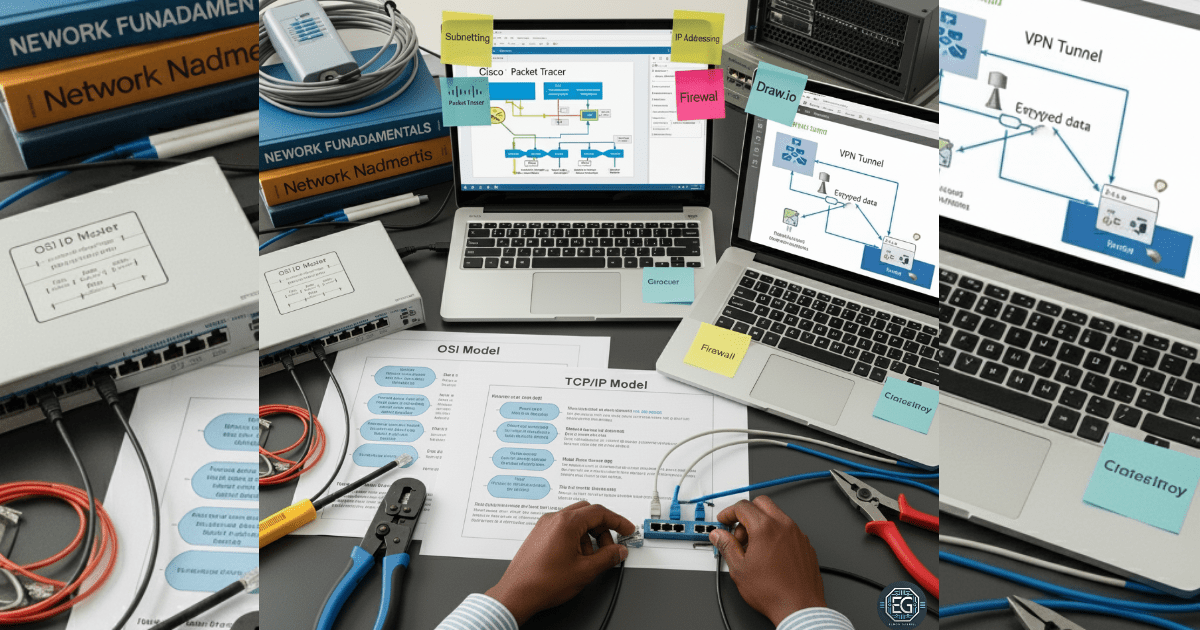The more you learn network fundamentals, the easier cybersecurity gets. Completing the Network Fundamentals section of the MSAF course was not just a checklist item—it was a milestone in my journey. This module involved hands-on labs that applied theory to real-world scenarios, mirroring the exact skills required by cybersecurity professionals.
Grasping the Theoretical Underpinnings
I began by building a strong foundation through research on the OSI and TCP/IP models:
- OSI model: A 7-layer framework for understanding network communication.
- TCP/IP model: The practical 4-layer model powering the Internet.
Understanding each layer is essential for spotting vulnerabilities, analyzing traffic, and implementing security controls.
Next, I researched common networking hardware used in enterprise networks:
- Hubs: “Dumb” devices that broadcast traffic to all ports.
- Switches: Targeted traffic delivery, more efficient than hubs.
- Routers: Manage traffic between networks.
- Firewalls: Protect sensitive data by controlling access and segmenting networks.
Putting Knowledge into Practice: Static & Dynamic Network Design
To test my knowledge, I designed a visual network with Draw.io for a 100-employee business. Every PC, switch, and server placement built the network; adding firewalls and a DMZ protected it. The result: a complete network diagram with secure segmentation and proper security controls.
The final challenge involved Cisco Packet Tracer to create a dynamic network for a 1,000-employee organization
Tasks Included
- Building WANs, LANs, and VLANs.
- Configuring Access Control Lists (ACLs) and Network Address Translation (NAT).
- Establishing an IPSec VPN tunnel, troubleshooting crypto parameters, and resolving command-line quirks.
This exercise took over 10 hours of intensive hands-on work and led me to create a troubleshooting guide for the final diagram.
Key Tasks Completed
- Researched the OSI and TCP/IP models and cybersecurity implications.
- Researched common networking hardware for enterprise networks.
- Designed a static network diagram using Draw.io.
- Built a dynamic network in Cisco Packet Tracer.
- Configured LANs, VLANs, ACLs, NAT, and IPSec VPNs.
ℹ️ Note: Full lab reports and video submissions are available upon request.
Conclusion
Textbook learning alone does not prepare you for advanced hands-on exercises like this. I gained practical, real-world skills and produced a complete two-part network project suitable for my cybersecurity portfolio.
Key Takeaways
- Hands-on experience designing static and dynamic networks.
- Learned to set up LANs, VLANs, ACLs, NAT, and VPNs.
- Built troubleshooting and documentation skills under real-world conditions.
- Applied OSI and TCP/IP theory directly to practical scenarios.
- Produced a portfolio-ready two-part network project.
Ethical Disclosure
ℹ️ Note: In line with my academic pledge at Mossé Cyber Security Institute (MCSI), official course solutions are not published. Instead, these posts reflect my independent work and interpretation of industry-relevant skills and tools. Supporting documentation is available privately for recruiters, mentors, or collaborators.


